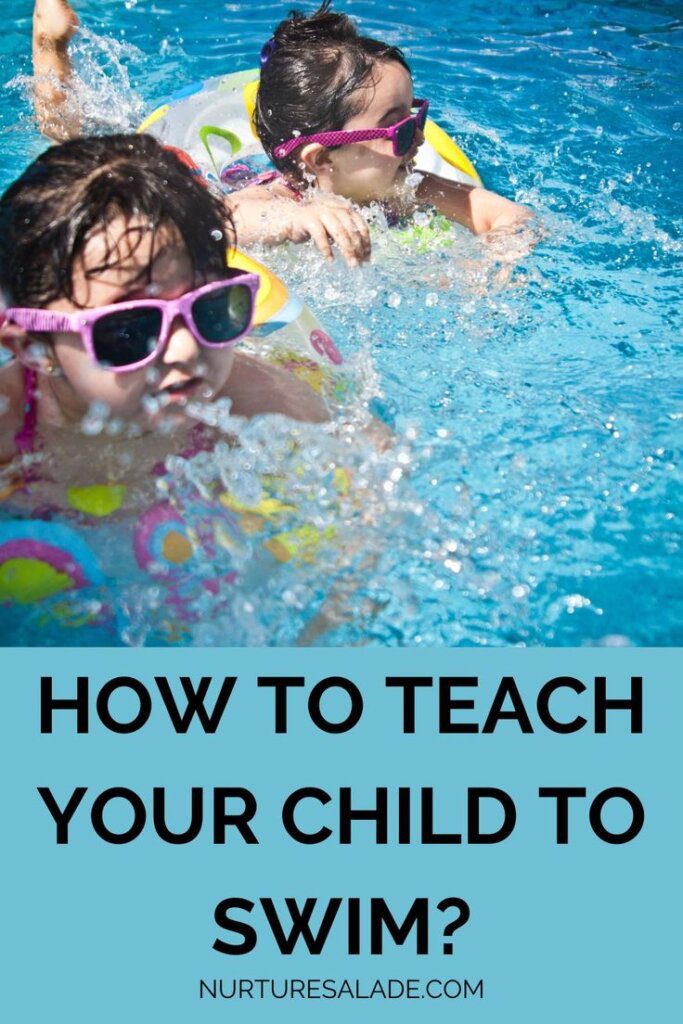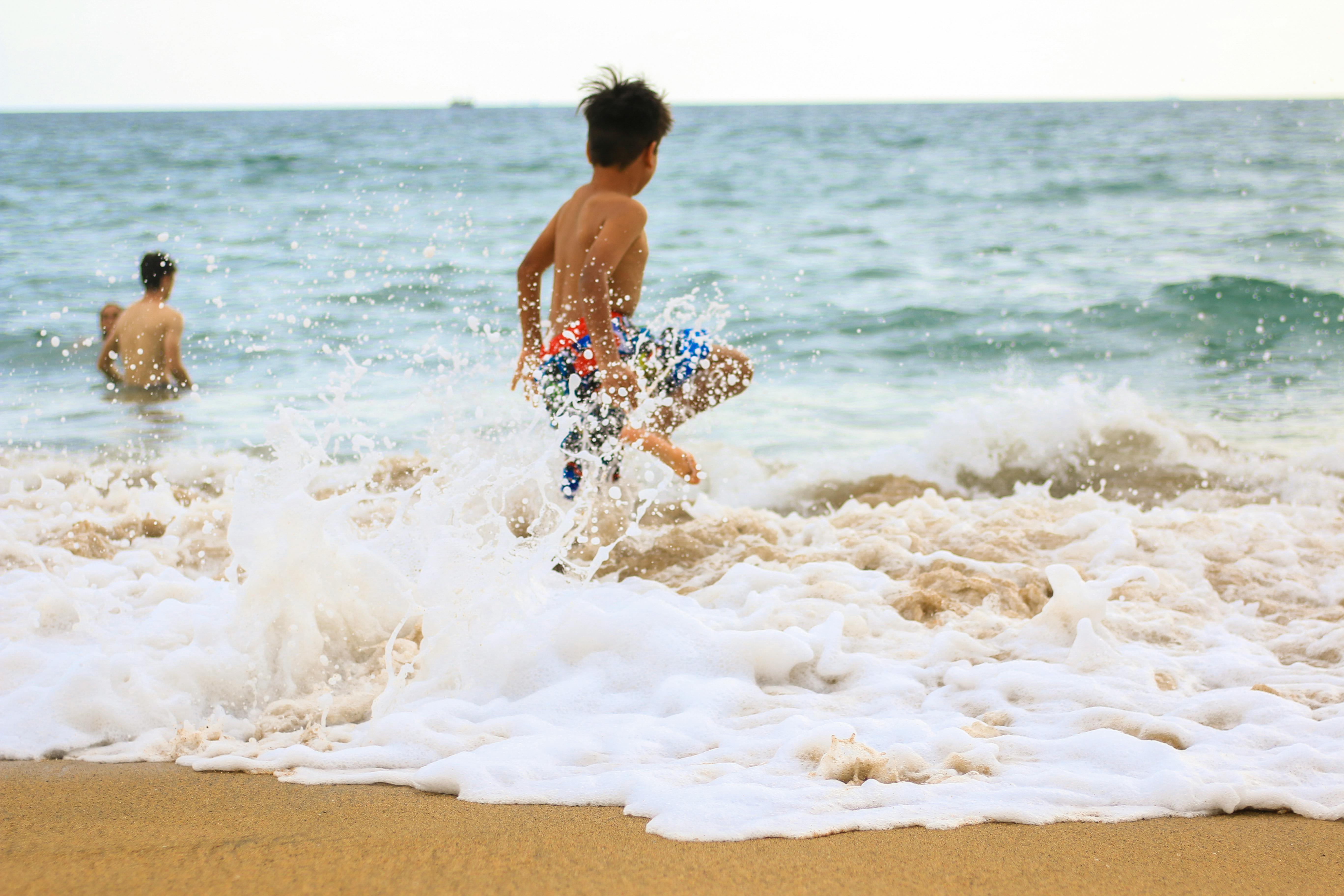Swimming isn’t just a necessary LIFE SKILL; it’s a vital part of your child’s growth and a fantastic way to have loads of fun in the water.
Imagine the joy of watching your little child effortlessly gliding through the water, their giggles echoing all around the pool.
What an amazing feeling, right?
But that imagination only comes to reality when you know how to teach your child to swim.
If you are not sure, don’t worry — I am here to assist you!
Whether you’re a swimming expert or someone who is just dipping your toes into the world of aquatic education, this article is here to lend a hand.
We are going to discuss some valuable tips and techniques that work well for kids of all ages – from tiny tots to energetic teens.
So, grab your swimsuits, and let’s dive into how you can give your child learn this essential skill.


How to Teach Your Child to Swim?
Teaching your child to swim can be an EXCITING and REWARDING experience for both of you.
However, it is essential to approach this process with patience, encouragement, and a focus on creating a positive and enjoyable learning environment.
Let’s discuss in detail how you can teach your child to swim appropriately.
Set Up a Schedule for Short Lessons
Swimming success doesn’t depend on how many hours you spend but on how well you learn during those moments.
Short, focused lessons, no more than 15 to 30 minutes, can work better than lengthy sessions.
And you know what? Kids stay interested and focused when they have short, engaging activities.
Consistency is the MAGIC INGREDIANT, as regular practice shapes kids into confident swimmers.
Make a schedule that works with your child’s routine – maybe a few times a week – and stick to it.
A routine helps kids know when to expect swim time and look forward to it with excitement.
Remember, it’s not a RACE but a JOURNEY.
Progress might be slow, but every small victory in these short lessons gets you closer to becoming a swimming expert.


Safety First
Explain that water can be exciting, but it’s also something we need to be careful about.
Share these words with your child and encourage them to hold them close:
- Ensure there’s always an attentive adult nearby supervising you when you’re in the water.
- Stick to the shallow parts of the water, especially when you’re just starting out. That way, you can stand up if you need to and feel like you’re in control.
- Just remember, being safe in the water isn’t something you learn once and forget. It’s like a song that keeps playing every time you swim – always stay safe!
Ensure your child understands these points and highlight the importance of implementing safety strategies to avoid any issues.
Address Your Child Fears
Water can sometimes seem mysterious and a bit scary to your child.
It’s normal for them to feel a little nervous, but with your help, those ripples of anxiety can subside.
Try to figure out what’s making them nervous.
It could be the deep water or getting splashed; talk to them about it and share your own stories. Introduce them to the water slowly and let them dip their toes and explore at their own pace.
Be sure to offer lots of encouragement and comfort. Their fear will gradually disappear.


Building Water Confidence
Confidence is the life jacket that keeps your child afloat while they learn to swim.
Start by dipping their toes in the shallow end so they can get used to the feeling of the water around them. As they become MORE AT EASE, move on to the deeper water, where they can stand and feel the gentle movement of the water.
Engage in fun activities that help them get comfortable, like:
- Blowing bubbles
- Splashing around
- Floating
You can also give them toys or floaties to help them stay afloat as they explore further.
These little achievements will make them more confident in the water.


Encouraging Proper Watering Techniques
Swimming isn’t just about moving in the water; it’s like a graceful dance that needs coordination and skill.
Nurturing proper techniques ensures a confident and efficient swimmer.
Explain the art of balance in water.
- Show them how a straight body line will make you move smoothly through the water.
- Encourage them to relax and not tense up, as being tense can slow you down.
Breathing in water is similar to following a pattern.
- Teach them to inhale while turning their head to the side during strokes.
- Practice this on dry land, and gradually, they’ll synchronize breathing with their strokes in water.
Start with floating is a must.
- Teach them to lie on their back, relax, and trust the water to hold them up.
- Move on to kicking and show how leg movement propels them forward.
All these watering techniques act as a base on which the whole bridge of swimming is built for your child.
Basic Swimming Strokes
Strokes refer to the specific techniques and movements swimmers use to propel themselves through the water efficiently.
They are crucial for swimming effectively and efficiently.
NOTE: It is essential to begin with the basics to lay a strong foundation.
Introducing Strokes
When introducing strokes to beginners, it’s essential to start with strokes that are relatively simple and comfortable for beginners.
Two of the most beginner-friendly strokes are freestyle (also known as front crawl) and backstroke.
Freestyle Stroke
Arm Movement: Teach your child to extend one arm forward while the other arm pushes back underwater. This alternating arm movement is a key component of the freestyle stroke.
Leg Movement: Combine arm movements with rhythmic kicking. The legs provide propulsion and help maintain balance in the water.
Breathing: Emphasize the importance of coordinating breathing with the arm and leg movements. Beginners should learn to turn their head to the side to take a breath while keeping their body in a horizontal position.
Backstroke
Body Position: Show your child how to lie on their back in the water. It is a significant aspect of the backstroke and essential for safety and proper technique.
Arm Movement: Teach them to move their arms in a circular motion. The arms should alternate, similar to the freestyle stroke, but they are done on the back.
Head Position: Stress the importance of keeping their eyes and face pointed toward the sky. This not only helps with breathing but also maintains a streamlined position.
Remember, these are the first strokes of their swimming story, and mastering them opens the door to a sea of possibilities.
Controlled Kicks
Kicking isn’t just a playful splash; it’s the propulsive force behind swimming.
Explain the significance of controlled kicks – they not only move your child forward but also build strength and stamina.
Begin with flutter kicks – small, quick movements from the hips down.
- Encourage them to keep their legs straight and their toes pointed.
- Practice against a wall or holding onto the pool’s edge for support.
Gradually introduce scissor kicks, where legs move in a scissoring motion.
- This develops coordination and control.
- Ask them to visualize a mermaid’s tail, guiding them to move their legs like one.
When your child learns all these steps, he will ultimately master the art of swimming.
That is the general guideline to teach a child how to swim. Now, let’s discuss some different age-wise attributes for complete understanding.
Age-Wise Guideline to Teach a Child to Swim
Teaching a child to swim is an essential LIFE-SAVING skill that brings joy, confidence, and physical fitness.
However, the process of teaching a child to swim should be approached with care and patience, taking into consideration their age, development, and comfort level in the water.
Here is an age-wise guideline to help you introduce swimming to a child:
Babies
In the earliest stages of their aquatic adventure, babies are introduced to the wonders of water.
The focus here is on creating a POSITIVE ASSOCIATION with the aquatic environment.
Gently hold your baby in the water, allowing them to experience the sensation of floating. Gradually introduce splashing and water play, ensuring they feel secure in your arms.


Toddlers
As toddlers begin to explore their watery world, it’s time to introduce basic movements.
Start with gentle kicking and encourage them to paddle their hands in the water. Incorporate playful games like floating toys, which help them develop coordination and confidence.
Gradually shift to independent floating, supporting them as they learn to balance and kick on their own.
Older Kids
As kids grow, their swimming skills can progress to deeper waters.
Focus on teaching proper stroke techniques, beginning with the foundational freestyle and backstroke.
Emphasize the importance of technique over speed at this stage. Introduce controlled breathing and build their endurance with longer swims.
Also, practice floating and treading water, ensuring they are equipped with essential water safety skills.
Teenagers
For teenagers, upgrading their swimming technique becomes vital.
Introduce more advanced strokes like breaststroke and butterfly, guiding them through the touch of each movement.
Work on improving their efficiency and speed while maintaining proper form.
This age group is also an ideal time to emphasize water safety rules and rescue skills.


NOTE: In each phase, patience and adaptability are key. Understand that every child progresses at their own pace and provide sufficient encouragement and support. The goal isn’t just to create proficient swimmers but to instill a lifelong love and respect for the water.
With all that, we’ve reached the end of our discussion. Now, let’s bring it all together in our conclusion.
Conclusion
Now, you know how to teach your child to swim.
When you’re teaching your child to swim, remember that patience and encouragement are your best friends.
Swimming isn’t just about moving your body in water; it’s a skill that brings happiness, confidence, and good health throughout life.
As you guide your child to this life-saving skill, safety must be your foremost concern.
Always be careful and address your child’s fears by understanding and letting them get used to the water gradually.
Follow age-specific advice to help your child learn step by step, and they’ll not only become good swimmers but also love and respect the water throughout their lives.
Now, get ready to have some water fun with your child and create memories that will stay with you forever!


